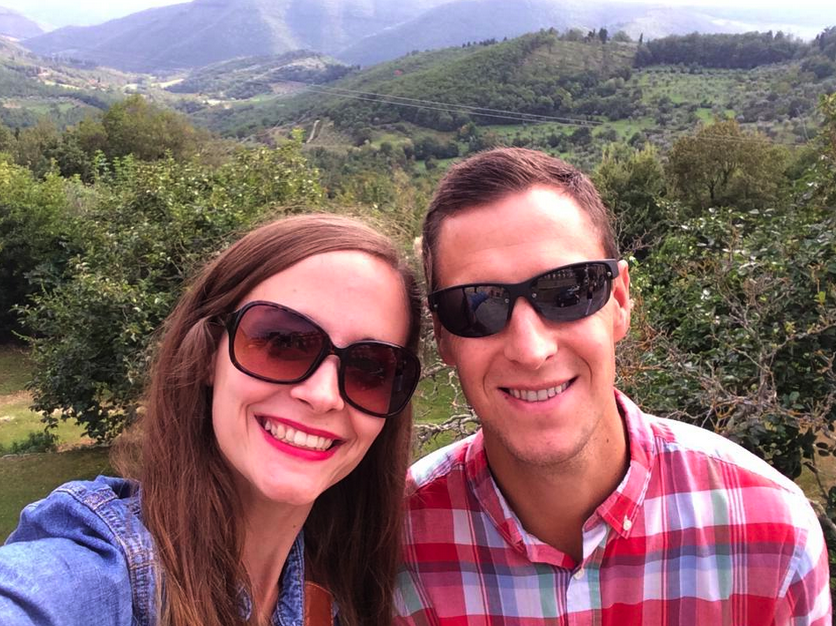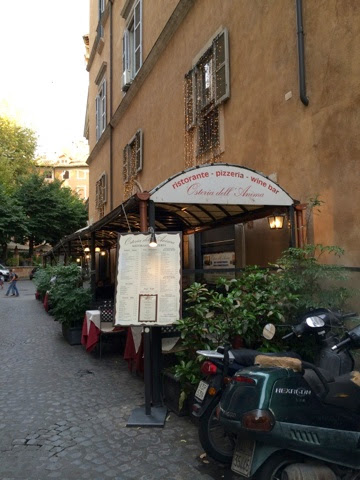The morning of our second day we wandered up to the central market, which is two parts: the first is a giant building with meat, cheese, pasta, produce..essentially a huge farmer's market; the second being the streets surrounding the market which turn into a big art fair with purses, scarves, and trinkets galore.
But since I took zero photos of that portion of our day (was too busy scoping out the treats and purses)- we'll skip on to one of my favorite parts of the entire trip, hands down: the wine tour. We took THIS tour and while I'll say, I was nervous to sign up for a tour on some random website, this was easily the best "risk" I've ever taken. The bus was super easy to locate right by the main train terminal and as we wound our way up switchbacks into the hills of Tuscany, the group leader gave us some history of the area.
One 40 minute bus ride later and we were at Castello del Trebbio- the oldest inhabited castle in Italy. It was built in 1100 by the Pazzi family (which means "crazy" in Italian). The Pazzi's were the second wealthiest family in Florence at the time, second only to the banking family- the Medici. Tired of being #2, the Pazzi came up with a plan to kill the Medici, but they had only one problem: no army with which to do it. So, they enlisted the help of someone who also wanted the Medici gone: the Pope. The Pope was the biggest debtor of the Medici and if they were gone, so was his debt, so he let the Pazzi use his army to do the deed. They hatched a plan to kill the family leaders on Easter Sunday in the Duomo. Only, the plan didn't work- and only one brother was killed. The Medici were enraged, but waited for their revenge. Some 20 years later, the Medici son became Pope. The Pazzi's were banned from Florence and those who were still alive, were killed and hung outside the Palazzo Vecchio. All art and coat of arms of the family were destroyed- all but one, that is, which still hangs in the doorway at the castle. Why was this one spared? Because it was made by Donatello (notice a theme of evil-art-appreciators?)
The grounds were stunning, the history was fascinating, and the wine was DELICIOUS.
I don't even like red wine but I learned I like a "young" chianti, because it's a touch fruitier than normal red's, which tend to be dry.
Chianti wine is named after the region the grapes are grown in, and in order to be a true Chianti, must be made with 80% sangiovese grapes. By law, the remaining 20% can come from elsewhere, but this particular winery uses 100% sangiovese.

As a part of the tour, we hopped back in the bus and drove 10 minutes to a nearby town, which was incredibly quaint. This was just to give us a flavor of "small town Italy" which was every bit as picturesque as you could imagine it would be.


There will always be more "sights" to see in every place you visit, so while I'm not a seasoned traveler, my advice will always be to take on at least one unique experience every place you go. I wouldn't replace this half-day tour with any museum or castle. It was so cool getting out into the countryside, and getting to hear about the process of wine making, and sample some fantastic wine.
I can't recall which night it was, so I'll include it in this post, but after returning to Florence we stopped back at the hotel and decided to venture out in search of dinner. M had an "idea" of what he wanted, and by that, I mean we would wander by menus and he would decide he didn't want something upon seeing it... without having narrowed down what he DID want. I was happy to go along with this method for the first twenty minutes, but I was starting to get impatient when we stopped outside a doorway to discuss our plan of attack. I looked at an advertisement for a "panoramic restaurant" and it hit me: this was the restaurant our friend we were meeting up with in Vernazza had recommended! It was a hotel rooftop (see the above "eat" category for details) that had great views of the city. The only catch was he had said we would likely need a reservation.
We trekked up to the top of the hotel and found ourselves on a rooftop with a ton of open tables. We sat down, and a server came over and asked if we were here for dinner. After replying, 'yes' he had us get up and follow him up yet one more flight of stairs, where we were seated at the very last table and enjoyed the most spectacular sunset, views of Florence, and meals of our lives. Seriously.



another fabulous day in Florence. Last up: a day packed with sight seeing.





